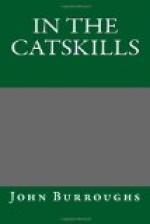The less skillful builders sometimes depart from their usual habit, and take up with the abandoned nest of some other species. The blue jay now and then lays in an old crow’s nest or cuckoo’s nest. The crow blackbird, seized with a fit of indolence, drops its eggs in the cavity of a decayed branch. I heard of a cuckoo that dispossessed a robin of its nest; of another that set a blue jay adrift. Large, loose structures, like the nests of the osprey and certain of the herons, have been found with half a dozen nests of the blackbirds set in the outer edges, like so many parasites, or, as Audubon says, like the retainers about the rude court of a feudal baron.
The same birds breeding in a southern climate construct far less elaborate nests than when breeding in a northern climate. Certain species of water-fowl, that abandon their eggs to the sand and the sun in the warmer zones, build a nest and sit in the usual way in Labrador. In Georgia, the Baltimore oriole places its nest upon the north side of the tree; in the Middle and Eastern States, it fixes it upon the south or east side, and makes it much thicker and warmer. I have seen one from the South that had some kind of coarse reed or sedge woven into it, giving it an open-work appearance, like a basket.
Very few species use the same material uniformly. I have seen the nest of the robin quite destitute of mud. In one instance it was composed mainly of long black horse-hairs, arranged in a circular manner, with a lining of fine yellow grass; the whole presenting quite a novel appearance. In another case the nest was chiefly constructed of a species of rock moss.
The nest for the second brood during the same season is often a mere makeshift. The haste of the female to deposit her eggs as the season advances seems very great, and the structure is apt to be prematurely finished. I was recently reminded of this fact by happening, about the last of July, to meet with several nests of the wood or bush sparrow in a remote blackberry field. The nests with eggs were far less elaborate and compact than the earlier nests, from which the young had flown.
Day after day, as I go to a certain piece of woods, I observe a male indigo-bird sitting on precisely the same part of a high branch, and singing in his most vivacious style. As I approach he ceases to sing, and, flirting his tail right and left with marked emphasis, chirps sharply. In a low bush near by, I come upon the object of his solicitude,—a thick, compact nest composed largely of dry leaves and fine grass, in which a plain brown bird is sitting upon four pale blue eggs.




